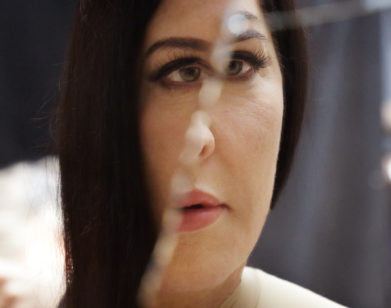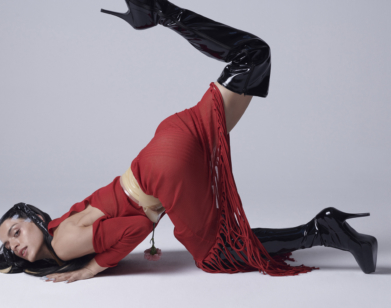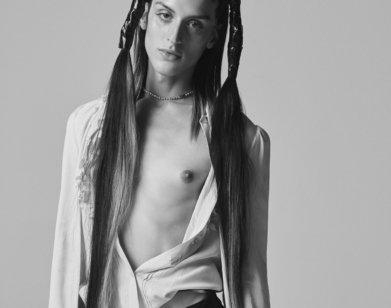Performance artist Tehching Hsieh talks taking risks with Marina Abramovic
“Life is a life sentence,” the Taiwanese-born artist Tehching Hsieh once said. Arguably no one has deployed that maxim to more extreme and illuminating ends than the speaker himself. Even considering the boon of limit-pushing, life-threatening performance art pieces that took place in the 1970s—from Vito Acconci’s 1972 work Seedbed, in which he masturbated under a ramp on a gallery floor, to Chris Burden’s many bodily infractions that included being crucified on a Volkswagen, shot in the arm, and stuffed in a locker for five days—Hsieh’s durational works shatter all of our conventional notions of liberty, safety, security, and solitude. Hsieh’s early works in Taipei—particularly his now famous 1973 jump from a second floor window, caught on camera, that ended in his breaking both ankles—point to his interest in the human body in conflict with the environment, as well as his willingness to suffer for his art. Hsieh also seems to be experimenting with the line between actions of purported value (work for money or advancement) versus acts that might seem valueless or costly outside of their aesthetic life.
In 1974, Hsieh, working as a sailor on an oil tanker, fled the ship when it was docked in an American port, and headed to the art-world capital of New York City as an illegal immigrant. It was here, in such a rich—and one often thinks socially free—city that Hsieh began formulating a series of durational performance works, each lasting 365 days without pause, that would define his legacy. For One Year Performance 1978–1979, Hsieh locked himself in a wooden cage that he built in his own Tribeca loft without any outside conversations or reading material, bridging the uncomfortable gap between religious monasticism and penal incarceration. For One Year Performance 1980–1981, Hsieh punched a factory time clock every hour on the hour; having shaved his head at the beginning, the series of self-portraits he took after marking each time card proved the duration of the piece by the length of his hair. For One Year Performance 1981–1982, Hsieh spent a year on the streets of New York, never once entering a building or any interior shelter (except for the 15 hours he spent in jail); through fall, winter, spring, and summer he bathed only once in a fire hydrant by the Hudson River, ate takeout he ordered through doors and windows, and left himself entirely vulnerable to the urban elements. For Art/Life One Year Performance 1983–1984, he tied himself to the artist Linda Montano by an eight-foot rope, and because they agreed not to touch for a year, that marathon of togetherness was as frightening as, and even more restrictive than, total isolation.
In 1985, Hsieh created another set of rules: he wouldn’t make, discuss, or see art for an entire year. In 2000, the Brooklyn-based artist (who finally became a U.S. citizen in 1994) decided to stop making art altogether. He now confines his practice to archiving and showing those master works. One such exhibition occurred at this year’s Venice Biennale, which introduced his year-long experiments to a whole new generation perhaps even more shocked than their predecessors by voluntary self-abnegation. This past summer, Hsieh, now 66, stopped by the Manhattan apartment of his friend and admirer Marina Abramovic, a fellow performance artist who famously sat in the atrium of MoMA for six days a week until she reached 736 hours. Clearly they had things to discuss.
MARINA ABRAMOVIC: Did you really think you were going to fly when, at age 23, you jumped from the second-floor window of a building and broke both of your ankles in Jump Piece?
TEHCHING HSIEH: No. It was more of an experiment. Maybe I thought I was Yves Klein and could fly like he did [referring to the famous 1960 picture Leap Into the Void, of the artist bounding from a suburban rooftop in Paris]. But Jump Piece is not a mature piece. It was conceived quickly—all I needed was a window and a camera—and I knew the pain would be quick, too. I wouldn’t do that kind of thing anymore. I knew I’d likely get hurt, but I didn’t even think about the possibility of broken legs. I overestimated myself … or underestimated the concrete below.
ABRAMOVIC: Tehching, the difference between you and Yves Klein is a very big one. You are real, and you jumped in real life. Yves Klein’s jump is unreal. He knew he couldn’t perform that leap without hurting himself, so he made that as a photomontage.
HSIEH: You say unreal, but he is very important for those of us who use action. I quit painting very early. I just jumped ship. In a way, the window is the tragic possibility—you can jump out into your future. That kind of action is more like a direction. It’s that same thinking that brought me to New York.
ABRAMOVIC: You jumped into New York in 1974.
HSIEH: And into myself. I was here for 14 years without a green card, surviving. I did it without getting the necessary paperwork. So I’ve grown into the role of my work.
ABRAMOVIC: In that jumping piece, as well as your other work, I see a direct link from Yves Klein to the Gutai group in Japan [a collective founded in 1954 whose work anticipated later performance art] to the Dutch artist Bas Jan Ader, who also created without a net, and finally to you. The last is Tehching. We are talking about jumping—over something, into something, through something. One member of the Gutai group, who isn’t much talked about, attempted to make a final painting by placing a canvas on the floor and jumping to his death on it from a great height.
HSIEH: He jumped and then died?
ABRAMOVIC: Right onto the canvas. And, as we know, Klein was influenced by the Gutai group when he visited Japan in the 1950s.
HSIEH: I know. He also learned martial arts.
ABRAMOVIC: Yes, he got a black belt. And it’s clear he took ideas from the Gutai group back to France as inspirations—one of which became that “photoshopped” leap. Then Bas Jan Ader made a career out of jumping. It started with books—from reading the first sentence and letting his eye fall to the bottom of the page. Then he fell from chairs, sitting on the roof in a chair and falling off; then he fell from a bicycle into a canal, then from a tree branch, and his final fall was horizontal—he would cross the Atlantic in a small boat and reach Europe from America. He never made it across the ocean.
HSIEH: He disappeared. Nobody knows what happened.
ABRAMOVIC: Anyway, my point is, even if you don’t think of Jump Piece as a mature work, it is extremely important because you’re in a line of artists who did something real. Whatever it was, it was a real action that carried with it the possibility of accident or death. And you continued that in every subsequent work. Your work has always been real and honest—in One Year Performance 1980–1981, you made sure that every single hour of that year was recorded. Why is that kind of honesty so important to you?
HSIEH: Because I can’t do it dishonestly. I perform in art time and in real time, and you can’t tell the difference—no one knows how to separate a real act from an art act in my work. When I lived on the street for a year, people only knew that I was homeless. They didn’t know that I was an artist doing a piece. I have to use real time in my work. I do, however, have to find a subtle way of documenting real time, in order for people to have a response. That means punching into a work clock every hour in the case of one piece.
ABRAMOVIC: Is agreeing to punch in every hour the equivalent of some sort of hardcore Buddhist meditation tradition? It almost seems religious in its discipline. How can your mind not shift after three months and say, “Fuck, I’m going crazy. This is ridiculous!” It’s so hard to keep that kind of performance up. I know from experience.
HSIEH: There is no simple answer. It would be impossible to understand a work by talking about one week of training or experimenting to prepare for it. Rather, you’d have to understand my philosophy and the influences of my life, where I’m coming from and all the philosophers and literature I’ve read. They’ve influenced me and enabled me to create these works. Now, a lot of people look for answers in spirituality or different texts, but for me this is life. This is what life is: the passage of time. It’s not about how to pass the time, but about the acceptance of the time passing. I know people think of my work as spiritual, but really it’s just that I consume time. That’s all.
ABRAMOVIC: That’s true and not true. If a man sits in solitude for ten years in a cave, he comes out of that experience a different person. If anyone did the same thing you did for one year, they would come out of it an entirely different person. Whatever you want to call it, there is some transformation.
HSIEH: I’m trying to say that I’m the same and also different.
ABRAMOVIC: One fascinating element about your work is how it plays with so many shifting contexts. There is a religious context, an artistic context, a social context. But there is a transformation taking place no matter which context we are speaking of—yes or no?
HSIEH: For me, I make a schedule and I pass the time. I don’t think about the transformation. When my schedule says I’m finished on this day, I put it in the past and go toward my future.
ABRAMOVIC: This blows my mind! In a way, these pieces are tools, then, to accept life as it is. That’s why these works will never die, because you are dealing with the nature of life itself.
HSIEH: Each of these projects you are referring to required one year of work—two equinoxes. One year to me is just a small section of life. For most humans, one year is a long time and so much happens. But for the universe, it’s very temporary—
ABRAMOVIC: That’s not even one second for the universe.
HSIEH: Yeah, and in this way I know I am a human being. I can give myself to one year for a project. That is why I say I’m primitive in the way I work, especially compared to most artists. I came to New York in 1974, knowing that it is the art center of the world. But I didn’t go to find people for my work. I do the work, and the people come to me, and I learn from them. That has always been my approach—to do the job first and then to respond to it after I finish and learn what people think about it. That’s how I develop, and I’m more of an outsider in that way. I communicate very slowly and in my own language, and it takes time. That is why I appreciate you including me in that line of artists.
ABRAMOVIC: Sweet baby. [both laugh] Be less humble. You have that disease where you’re overly humble. I talk to artists all the time who have egos as high as the Himalayas and their art is often bullshit. Not you. Okay, so I have a question about repetition, about the repetition of the same activity or action in the same period of time. It can be easy to achieve and very difficult to maintain. Why is repetition so important to you? Punching the clock, being in the cell, and waking up and sitting in one corner of the bed; it’s all so precise. Even when the Hudson River is your bathroom and the street is your kitchen, you create a small universe inside a
big universe; you’re always so well organized.
HSIEH: I come from a painting background, and although my painting is completely different from my performances, there is something about the fundamentals of that training that transfers over to this idea of an exercise and being diligent about mapping something out in advance—even if it is just being aesthetically diligent.
ABRAMOVIC: What was your first painting?
HSIEH: I didn’t go to art school. I quit high school.
ABRAMOVIC: You’re avoiding the question! [laughs] A curator recently saw my early paintings and pointed out that they already had an element of performance to them. I was shocked to see that, but I was also made aware of how important first works are in finding your direction—even if you are ashamed to show them. I was. So tell me what your first painting was.
HSIEH: I can’t really answer what my first paintings were. I was 10 years old when I did them. I painted myself, my own portrait.
ABRAMOVIC: There you go, that’s the answer. You painted yourself. Thank you. Done, done, done. [both laugh]
HSIEH: I painted myself and I didn’t like the way my face came out, so I cut that head out and put a new one in its place. I had to make the portrait to my liking. But I didn’t consider that art.
ABRAMOVIC: That’s not for you to say. That’s for history to decide. Artists tend to make all the wrong choices about which of their works will end up being the most important.
HSIEH: Why do I have to wait until after I die? But maybe that is okay. The world has always been slow to respond to my work.
ABRAMOVIC: The world has been slow because your work is so advanced. Society can’t understand it when they first see it.
HSIEH: I think my problem is that I don’t have the tools of language.
ABRAMOVIC: Well, why did it take you so long to learn English?
HSIEH: Because I like being primitive, okay?
MARINA ABRAMOVIC IS A NEW YORK–BASED PIONEER OF PERFORMANCE ART. A RETROSPECTIVE OF HER WORK, “THE CLEANER,” TRAVELS TO THE HENIE ONSTAD KUNSTSENTER MUSEUM IN NORWAY THIS MONTH.







